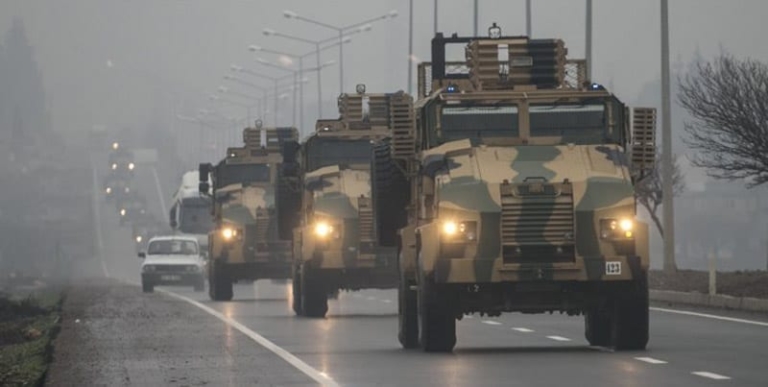
The Turkish-Russian relationship has seen many changes since Turkey shot down a Russian jet over its territory in 2015. That incident was quickly forgotten as relations between the two countries improved. A new phase of bilateral cooperation on trade and Syria began to show Turkey distancing itself even from the United States and NATO allies. Today, following Turkey’s accusation of Russian collusion in the Syrian air force’s killing of 33 of its soldiers in Idlib, tensions have risen between Ankara and Moscow, with the former requesting a meeting of NATO and preparing for perhaps the largest revenge military operation inside Syria.
There is no question that this development points to a completely new direction of events in Syria where Russia continues to support and consolidate Bashar al-Assad’s rule and attempts to conquer whatever is left of territories outside his control—and, in the process, subverting its Astana and Sochi understandings with Turkey. This is seen as anathema to Turkey’s interests after Ankara conceded to accepting Assad’s regime and dealt with it through the Russian intermediary. In exchange, Turkey acquired a border strip under its control through which it could halt the flow of Syrian refugees and prevent the establishment of a Kurdish enclave on its southern borders.
From its side, Russia decided to side fully with the Assad regime and may now be convinced that it could force Turkey to accept a radical change in conditions on the ground without negatively affecting bilateral relations painstakingly built over the last few years. In reality, however, Russia was surprised by the adamant response of Turkish President Recep Tayyip Erdoǧan and other officials who warned Moscow not to support Assad’s military campaign against Idlib. In addition, the almost complete silence by American officials about the campaign or Russia’s involvement in it did not help the situation, which has produced a humanitarian disaster with more than 900,000 civilians fleeing to the Turkish border for safety since December 2019.
The Syrian Regime’s Strategy
There are no political or military indicators that the Syrian regime—aided by heavy participation of the Russian air force and Iran-supported militias—will halt its current attack against Idlib and the Aleppo countryside. The regime also hopes to control those areas that Turkey had earlier placed under its sway during its Operation Euphrates Shield and the cities of Tal Abyad and Ayn al-Arab along the Turkish-Syrian border. This will likely lead to a humanitarian disaster since the more than three million Syrians there will not be able to find shelter from the regime. These internally displaced Syrians had come to the north after being expelled by regime operations and indiscriminate bombing in Homs, Aleppo, Eastern Ghouta, and other areas. Indeed, there is no more “north” to which refugees can flee except Idlib, which is currently under siege and in danger of being overrun.
There are no political or military indicators that the Syrian regime—aided by heavy participation of the Russian air force and Iran-supported militias—will halt its current attack against Idlib and the Aleppo countryside.
The danger has always manifested in Russia’s partial solutions for areas besieged by the regime: to expel and bus opposition fighters and civilians in their areas to safer zones. What this has wrought over the last few years is a concentration of fighters and refugees in the north of the country that Assad eventually will want to control. He is also concentrating his military efforts on taking charge of major transportation arteries such as the M5 highway connecting Aleppo to Damascus. Over a short period of time, and with help from Russia’s air force, the regime has been able to occupy some 100 cities and towns in the Aleppo countryside and Idlib, all of which had been under the opposition’s sway. It is noteworthy that these victories were accompanied by flagrant violations of humanitarian law as Syrian and Russian jets attacked and destroyed scores of hospitals and schools, a situation that spurred hundreds of thousands of residents to flee their homes.
The Russian Strategy
Over the years, Russia has tried to separate the political from the military track in the Syria conflict by organizing the Astana talks that led to the establishment of de-escalation zones around the country such as in Idlib and Aleppo, Homs, Eastern Ghouta, and the southern Daraa and Quneitra provinces. These talks also established de-confliction zones and observation areas such as those managed by Turkey in Idlib and its environs. In the absence of an effective United Nations and American presence, however, Russia exploited ambiguities in the agreements on these zones to help the regime in controlling most of them and expelling the opposition. Today, the only zone that remains outside the regime’s control is that in Idlib, which Turkey is trying to maintain and defend during the latest military operation there.
To be sure, Russia effectively used the Astana talks to derail the Geneva track, begun in 2012, that was organized by the United Nations to address matters of political transition in Syria. For its part, the Assad regime resorted to military operations both to subvert the Geneva track and work around the restrictions imposed in the Astana talks, which Russia had said would be the best option to impose a ceasefire on combatants. The regime’s operations dealt a blow to the ceasefire and forced the expulsion of hundreds of thousands of civilians.
Russia cannot be assumed today to choose to halt military operations in Idlib and its surroundings, an area Moscow has long identified solely as a terrorist haven that must be conquered.
Moreover, Russia worked at the United Nations to subvert any attempts to end the Syrian conflict. Since 2011, it has used its veto power 14 times against UN Security Council resolutions, the latest of which, in December 2019, aimed to prevent the renewal of a prior resolution that allows the entry of humanitarian assistance without notifying the Syrian government. This has precluded the international community from punishing the Syrian regime for its flagrant violations of human rights and humanitarian laws. To be sure, Russia cannot be assumed today to choose to halt military operations in Idlib and its surroundings, an area Moscow has long identified solely as a terrorist haven that must be conquered. It also wants to force Turkey to accept Russia’s rationalizations, possibly counting on Ankara’s perceived weakness as the United States refrains from showing full support of the Turkish position in Syria.
The American Position
In 2017, the United States rejected the Astana track and its de-escalation zones, considering the track an illegitimate alternative to the Geneva negotiations. Washington also had a serious objection to the role Astana gave to Iran as a third guarantor of the zones, especially that Iran has always functioned as Bashar al-Assad’s supporter and defender. This was clearly in line with the American position on Iran in general.
Still, the United States refused to offer any alternative strategy for dealing with the Syrian dilemma other than timid criticisms of the Astana talks. Today’s battle for Idlib shows Washington’s clear reluctance as President Donald Trump continues to believe that involvement in Syria is a losing proposition. In addition, the United States has not exerted any pressure on Russia to halt the military operation in the province despite Turkey’s attempts to elicit American support and the telephone conversations between Presidents Trump and Erdoğan. What is clear is that the Trump Administration does not feel it is imperative to intervene in the Syrian conflict despite the dire humanitarian conditions. Such a situation will undoubtedly have serious ramifications for Turkish-Russian and Turkish-American relations in the future. It also may impact the resolution to the question of Syrian refugees in Turkey and Europe, especially now that thousands of them may again cross Turkey’s borders to the continent.
What is clear is that the Trump Administration does not feel it is imperative to intervene in the Syrian conflict despite the dire humanitarian conditions.
The United States is thus called upon to view the Syrian crisis as more than merely a refugee crisis that requires a humanitarian response. Washington would do well to look at the situation from the angle of correcting the regional strategic imbalance because Iran may finally succeed in controlling Syria, Lebanon, and Iraq if the Assad regime succeeds in Idlib. Washington also should reemphasize the issue of a democratic transition in Syria, which Secretary of State Mike Pompeo addressed recently.
Finally, the question today is whether the United States and its NATO allies are going to support Turkey in its conflict with Russia in Syria. It is still difficult to determine if the alliance is required to invoke its Article 5 provision about an attack on one of its members, but a clear position from the Trump Administration would most assuredly send a message to Russia. On the other hand, as President Trump remains reluctant to take a firm stand with Russian President Vladimir Putin, Turkey may see itself standing alone, at least for the time being.
Photo credit: Anadolu Agency

